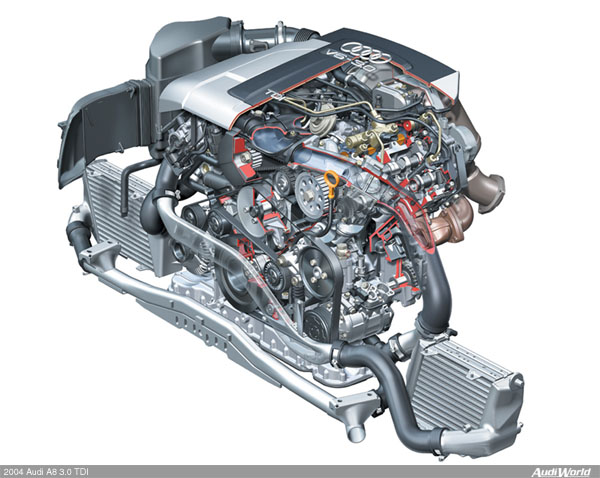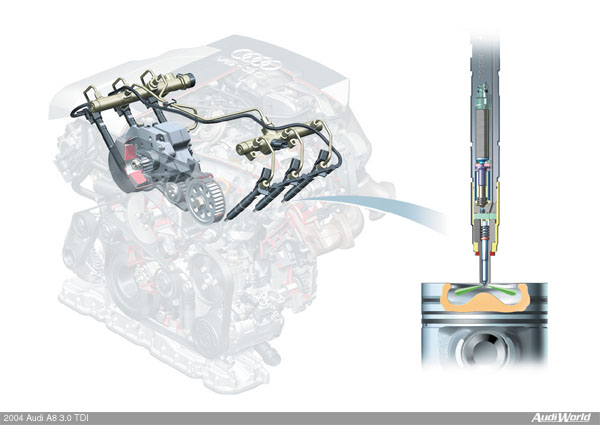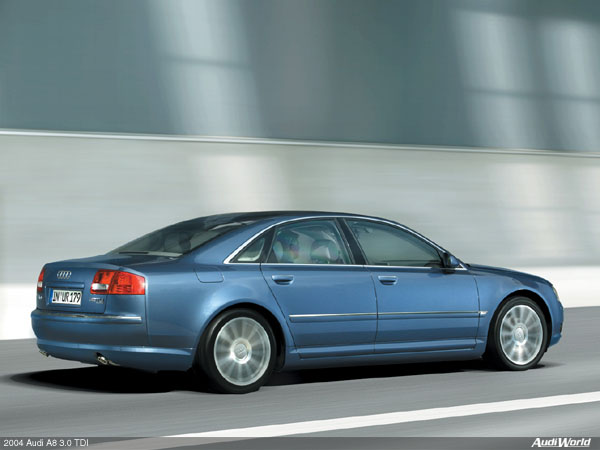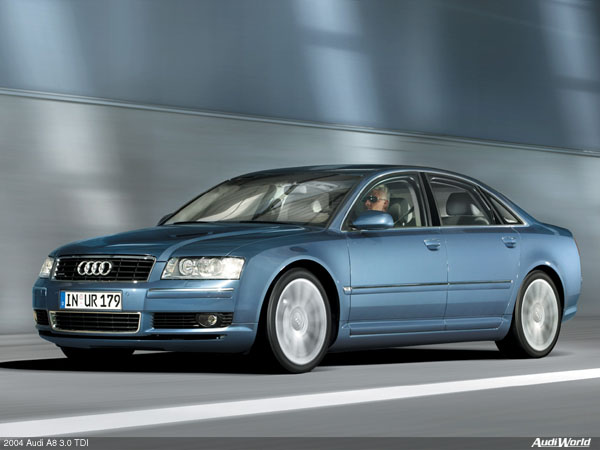Audi A
 |
|||
| September 7, 2003 8 3.0 TDI quattro Since its debut in the autumn of 2002, the Audi A8’s convincing road dynamics, advanced technologies and highly exclusive design and equipment standards have confirmed it as a symbol of sports character in the luxury car segment. A new V6 TDI engine has now been developed and is being offered as a fifth and once again a particularly sporty engine option for the A8. In the A8 3.0 TDI quattro it develops 171 kW (233 bhp) at 4000 rpm and has a maximum torque of 450 Newton-metres all the way up the engine-speed scale from 1400 to 3250 rpm. The A8 3.0 TDI quattro remains the first and only diesel car in the large luxury class to be available with a six-speed tiptronic transmission and permanent all-wheel drive, and also to outperform the tough EU4 exhaust emission limits that will not come into force until 2006. With its turbocharger and mapped-control, cooled exhaust gas recirculation (EGR), the V6 not only differs in engine size and additional power output from the previous 2.5-litre, 132 kW (180 bhp) version. It is also the first six-cylinder TDI from Audi’s new family of vee engines, and has the camshafts and oil pump driven by chains. The new engine also has extremely advanced fuel injection, the first time that the very latest common-rail generation has been used on an Audi V6 TDI. Piezo inline injectors permit up to five separate amounts of fuel to be injected on each working stroke, at an injection pressure of 1600 bar. These devices help to keep emissions to a minimum and achieve an agreeable noise pattern. In performance terms, the A8 3.0 TDI quattro lies well ahead of competitors’ six-cylinder diesels in the large luxury car category. This lightweight luxury saloon with its aluminium body takes only 7.8 seconds to sprint from a standstill to 100 km/h – a figure unequalled by any V6 diesel saloon on the international market. It can also reach a top speed of 243 km/h, and its peak torque of 450 Newton-metres provides the driver with abundant pulling power in every road-speed and engine-speed range.
Following the 4.2-litre spark-ignition engines used in the S4 and allroad quattro 4.2 models and the 4.0 TDI, also with eight cylinders, the 3.0 TDI is now the fourth member of the new Audi vee-engine family. The V6 TDI engine is also an extremely compact design, with an overall length of only 440 millimetres. The crankcase of the V6 engine and its two cylinder blocks, which are at a 90-degree included angle, are made from vermicular graphite cast iron, a material with twice the strength of conventional grey cast iron, but weighing some 15 percent less. This is a major step towards reducing the weight of the engine to only 220 kilograms, which makes the 3.0 TDI one of the lightest V6 diesels available anywhere. The power-to-weight ratio and the car’s front-to-rear weight distribution – two values that are of key significance for the new A8 3.0 TDI quattro’s dynamic performance – both benefit from this low figure. Compared with the previous engine, both the cylinder bore (now 83.0 mm) and the stroke (now 91.4 mm) have been increased. The total swept volume is now 2967 cc. In the new engine block the cylinders are 90 mm apart, compared with the previous figure of 88 mm. The compression ratio has been reduced from 18.5 to 17.0 : 1. Four valves per cylinder ensure optimal combustion chamber filling. The new V6 engine’s valves are actuated by roller cam followers with hydraulic clearance adjustment. This low-friction valve gear makes a big contribution to the 3.0 TDI’s lower fuel consumption and reduced emissions. The engine’s noise pattern also benefits from the use of roller cam followers. Together with the camshaft drive gears, which are tensioned to eliminate as much tooth backlash as possible, mechanical noise from the valve gear is lower, so that the 3.0 TDI proves to be a very smooth, quiet-running engine. An engine block of extremely rigid design and an effective engine enclosure also help to keep the six-cylinder engine’s noise emissions down to a very restrained level. A further extremely significant contribution to this exceptional engine refinement is made by the smooth combustion process, with optimised pilot injection from the latest generation of common-rail fuel injection systems.
Fuel is supplied to the combustion chambers by the latest generation of common rail fuel injection, the Bosch CRIP II+. This has a high-pressure pump and a separate distributor rail for each bank of cylinders. The maximum injection pressure is now 1600 bar, 250 bar higher than on earlier common-rail systems, and a value that can best be visualised as the weight of a complete midsize car pressing down on the area of a fingernail. This high injection pressure atomises the fuel still more effectively, so that the resulting mixture is more satisfactory and burns efficiently in the combustion chambers. Not only additional power and torque result, but also lower fuel consumption and emissions. The most important innovation in this new common-rail system are undoubtedly the piezo injectors. To utilise the so-called `piezo effect’ for fuel injection, an electrical charge is applied to a ceramic element and causes its crystalline structure to change. The resulting very slight change in its geometry, supported by a hydraulic device, opens the injector needle mechanically. Piezo injectors have a number of advantages compared with the conventional solenoid valve. The moving mass at the injector needle is cut by 75 percent, for example, and weighs only four instead of the previous sixteen grams. This makes it possible to deliver even smaller amounts of fuel accurately, and also increases the speed of injector needle movement. This is now 1.3 metres per second, which means that the piezo injectors react twice as fast as those used in other common-rail injection systems. As a result, the number of injection strokes on each working cycle of the engine can be varied almost without restriction. For the 3.0 V6, the Audi TDI development team decided to inject fuel at four successive points: at low engine speeds there is a double pilot-injection stroke as well as the main injection stroke; at moderate engine speed a single pilot injection stroke is used. At about 2500 rpm and high part-load, a single post-injection stroke is also performed. This strategy cuts emissions as well as making the combustion process smoother, so that engine noise levels are reduced. The 3.0 TDI engine is not only significantly quieter and smoother than its forerunner, but in fact undoubtedly sets the benchmark in this area for all other engines in its class. Fuel is injected into the combustion chambers through seven-hole injector nozzles. These too help to distribute the fuel uniformly, achieve particularly efficient combustion and therefore reduce undesirable exhaust emissions. Quality that satisfies even the toughest standards: the new Audi A8 3.0 TDI quattro, in contract to its competitors, has permanent all-wheel drive and a six-speed tiptronic transmission as standard equipment. Thanks to its admirably low untreated emissions, it nevertheless remains well below the EU4 emission limits, which will not become law until 2006. Engine management on the V6 TDI is in the hands of the Bosch EDC16 system, which regulates fuel volume, the start of the injection stroke, the turbocharger’s boost pressure and the degree of exhaust gas recirculation. As on the A8 with spark-ignition engine, this electronic system makes it possible to start the engine automatically at the touch of a button. The rapid pre-heat system with its ceramic glow plugs brings the 3.0 TDI to life without delay even at very low winter temperatures, in other words without the irritating waiting period typical of diesel engines in the past.
To ensure the best possible cylinder charge in all operating situations, the 3.0 TDI six-cylinder engine has a turbocharger neatly installed in the vee between the cylinder blocks in order to save space. For maximum efficiency the intake air temperature is lowered effectively and with minimum pressure loss by two charge-air intercoolers operating in parallel. They are located behind the inlet apertures in the front apron and therefore directly exposed to the airstream when the car is in motion. The turbocharger on the new 3.0 TDI engine has variable turbine geometry with an electric adjuster. This alters the angle of the turbine blades more quickly and accurately, so that boost pressure builds up with a minimum delay at low engine speeds in particular and the engine’s response to accelerator pedal movement is improved. Blades of optimised shape on the impeller and turbine wheels make a further contribution to efficiency, with the result that this engine does not suffer from unpleasant `turbo lag’. Continuously variable swirl flaps are incorporated into the intake manifold. They enable the airflow to be adjusted to suit engine speed and load. A greater degree of swirl at low loads optimises the combustion process, whereas at high engine loads the best results are obtained with minimum swirl. Closing an inlet port at low load achieves the required increase in swirl, but the ports are opened at higher loads to ensure good cylinder filling. Effective exhaust emission control The exhaust manifolds are double-walled with an air gap in between, to ensure that the exhaust gas reaches the turbocharger and the catalytic converters that follow without significant heat loss. Effective cooling, on the other hand, is needed for the exhaust gas recirculation system, and is particularly important if emissions of oxides of nitrogen (NOx) and particulates are to be reduced effectively. The exhaust gas diverted through the recirculation system passes according to temperature and engine load through a water-filled cooler located in the vee of the engine, where it also takes up no unnecessary space. A bypass line avoids passing the exhaust through the cooler while the engine is still cold, so that hot exhaust gas reaches the catalytic converter sooner and causes it to light off. Once the engine is warm, the exhaust gas begins to flow through the EGR cooling system. Exhaust emission control is by means of a pre-converter located close to the engine and the turbocharger, and the main catalytic converter under the floor pan. All this equipment has the effect of keeping exhaust emissions from the A8 3.0 TDI well below the EU4 limits – a first in the luxury diesel category. Lower fuel consumption At least as welcome as the new engine’s efficiency in reducing exhaust emissions is its economical use of fuel. Despite its higher power output and torque, its fuel consumption has remained at the previous low level. The average figure according to the standard fuel consumption test is 8.4 litres of diesel oil per 100 kilometres. This is at the same favourable level as the previous A8 2.5 TDI quattro, despite an engine that develops 53 bhp more and the higher overall weight. A welcome spin-off is that new A8 3.0 TDI quattro can now cover a distance of more than a thousand kilometres before refuelling – a value that clearly reveals how perfect this sporty TDI luxury saloon is for long-distance travel. A8 3.0 TDI quattro: supreme sports character in the luxury segment The new six-speed tiptronic transmission with its dynamic shift program DSP and additional Sport program is available for the first time with a V6 TDI engine. Thanks to the additional forward ratio, power output and torque can always be controlled in such a way that no conflict arises between a spontaneous flow of power, high performance on the road and perfect refinement. At the same time the additional sixth gear ratio increases the overall spread between the lowest and highest gears, a decisive factor for greater dynamism on the one hand and optimal fuel economy on the other. Gears can also be selected manually, either by moving the selector lever to the tiptronic section of the gate or by using the `paddles’ behind the steering wheel, an ergonomically perfect solution that has already proved its worth in the Audi R8 Le Mans-winning cars. The driver can for instance change gear while the car is being cornered, without having to move a hand away from the steering wheel. The quattro permanent all-wheel driveline still sets the standards in the luxury car segment. It converts the maximum amount of engine power into traction at the wheels and enhances lateral location of the vehicle; even the very considerable torque that this engine delivers can be transmitted effortlessly and safely.
The aluminium body – the lightweight way to the top The innovative aluminium body, which uses the latest version of the Audi Space Frame ASF principle, is the immensely strong basis that acts as a key to weight saving, sporty performance and outstanding road behaviour. Compared with the first-generation A8, more large functional castings and extruded sections have been incorporated into the completely closed ASF, with the result that the total number of elements in the structure is now much lower. Static torsional rigidity is 60 percent higher and has led to a worthwhile reduction in vibration and an increase in safety and dynamic potential. The weight of the body-in-white is some 50 percent lower than a comparable pressed-steel body, which means minimum mass allied to maximum strength. The suspension: even more dynamic if the driver wishes The new Audi A8 has an evolved version of the previous aluminium suspension, with a four-link layout at the front and self-tracking trapezoidal-link rear suspension. The brake system has also been redesigned, and the steering, with variable ratio and servotronic power assistance, is also new. The adaptive air suspension – a `4-corner’ system with continuously variable shock absorber settings, succeeds in resolving the classic conflict of objectives between good handling and a standard of ride comfort worthy of this class of car. In every driving situation, adaptive air suspension selects the most suitable suspension characteristics, modifies the damping action to reduce body movement and optimises road holding and ride quality. Data from four sensors at the wheels and three acceleration sensors on the body are evaluated by the adaptive air suspension’s central control unit. This defines the driving situation and within a few thousandths of a second computes the necessary adjustment signals that are transmitted to the individual shock absorbers, with the aim of maintaining optimal road dynamics and ride comfort at all times. The driver can also choose between four pre-defined settings extending from a clear sporty emphasis to the highest level of ride comfort, and ensuring that no wish is left unfulfilled. The MMI control concept: maintaining choice, reducing complexity Audi’s MMI integral user interface for the A8 is an infotainment platform and a control concept that uses strictly logical principles to make it easy to use. For the driver, MMI consists first and foremost of the user controls (the MMI terminal) in the centre console, with a control knob that can be turned and pressed in and four control keys grouped around it. At the sides of the terminal there are altogether eight function keys that can be used to select the most important main menus directly. There is also a return key to revert to the previous menu level. Above the centre console, is the second central MMI unit, a 7-inch format colour screen that can be retracted into the fascia but, when raised, is ideally positioned in the driver’s field of view. The basic layout of the screen display corresponds in its details with the positions of the control keys and control knob on the MMI terminal. This creates an intuitive link between what can be seen and the hand movements that have to be performed. The more often a function is selected by the driver, the higher it rises in the menu structure so that it can be reached easily and quickly. |




